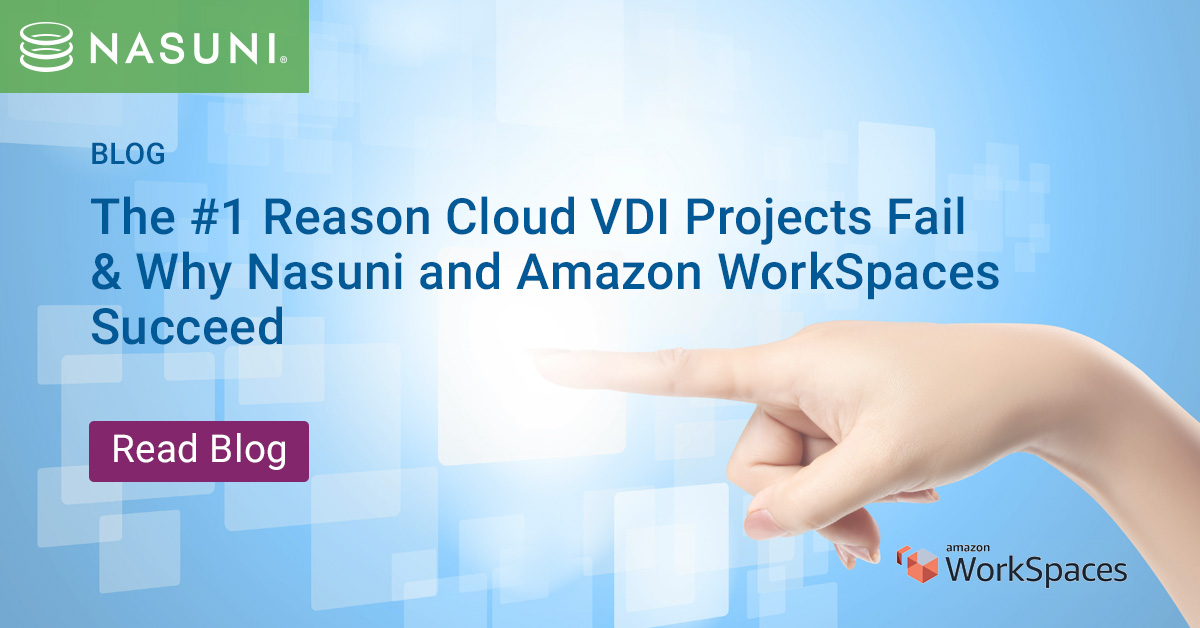The #1 Reason Cloud VDI Projects Fail & Why Nasuni and Amazon WorkSpaces Succeed
In this blog you’ll learn how Nasuni and Amazon Workspaces solves for the main problem with Cloud VDI deployments – end user performance.
September 15, 2020

I was lucky to be on the team that founded the first Desktop as a Service (DaaS) company so I’m familiar with the promise and perils of the technology. Before I get into the advantages of Nasuni with Amazon WorkSpaces let’s start with the VDI value proposition.
Traditional on premises VDI is often pitched in one of two ways. The first focuses on management and security. Unlike traditional desktops, a virtual desktop can be crippled by viruses at night and spun up fresh and secure in the morning, without a glitch. It’s much easier for large enterprises to centrally manage virtual desktops, too, as opposed to pushing out patches and upgrades to countless endpoints – especially in our current remote work environment.
The second value proposition focuses on the work-from-anywhere on any device functionality. Long before COVID-19, VDI solution providers were busy selling enterprises on the promise of allowing their users to be creative and productive from anywhere.
Now for the perils. The problem with traditional, on-premises VDI is that enterprises have to pay huge upfront costs and pay people skilled enough to operate those environments. You might spend hundreds of thousands of dollars building a data center to host those virtual desktops, then pay a premium for the deep technical expertise needed to make everything run smoothly. The vision of Cloud VDI was to deliver the same benefits – security, management, work from anywhere – without those large upfront costs. Instead of building a data center, enterprises would pay a recurring monthly cost per user.
Cloud VDI also solved one of the nagging problems with the traditional approach: poor performance. Companies would often build their VDI data centers in the middle of the U.S. in hopes of democratizing access. That was fine for the Chicago office, but users on either coast struggled with poor performance because of latency issues. Cloud VDI providers claimed to solve this problem by delivering the desktop from a cloud region close to the users.
So, users in the East would connect to a local cloud region. Those on the West would connect to a cloud on the West Coast. There was – and is – one major problem.
Even with Cloud VDI, companies are restricted by that immovable boat anchor known as file storage. If your desktops are in the cloud, but your files reside on a NetApp in Chicago or Los Angeles, London or Seoul, and those desktops must go through the wire to work on those files, the performance is going to be terrible.
End user performance is the number one reason Cloud VDI projects fail. The user experience can be terrible. Latency becomes intolerable, and IT throws up its hands, ditches the VDI approach, and starts buying its users new MacBooks and Dells so they can get back to work. Now we get to Amazon WorkSpaces with Nasuni, and why the two work so brilliantly together.
WorkSpaces is a fast, efficient, reliable way to spin up VDI in the cloud, and Nasuni ensures that your files remain close to those virtual desktops in the same cloud region. Nasuni starts by consolidating all your file shares and home directories in low-cost cloud object storage like Amazon S3 (learn more about VDI cost savings with Nasuni and AWS at our upcoming webinar). Then Nasuni works behind the scenes to cache frequently used files within specific AWS regions, and synchronize changes at a global scale to ensure that every region has fast access to the most recent versions of files.
The main problem with Cloud VDI deployments – end user performance – is suddenly solved. Your files aren’t anchored to a NetApp or Isilon array. They reside and scale in the cloud and are cached close to the cloud-based desktops, ensuring the kind of performance your users demand. Our enterprise customers who have adopted WorkSpaces still enjoy all the standard benefits of a Nasuni deployment, including:
- 50% cost savings relative to traditional file infrastructure
- Vastly improved replication and global file synchronization
- Reduced risk through built-in data protection and disaster recovery
- Enhanced data management
They’re also seeing great performance. Several of our large enterprise customers have adopted WorkSpaces and Nasuni since the start of the COVID-19 pandemic, and the feedback we’ve received from them is exactly what we’d hoped for:
Their end users are happy.
Find out more about Nasuni and Amazon WorkSpaces by visiting our dedicated microsite.